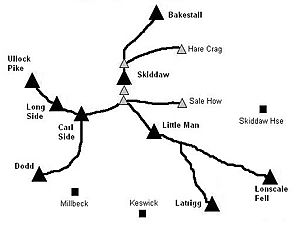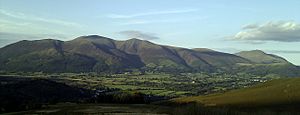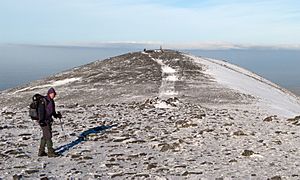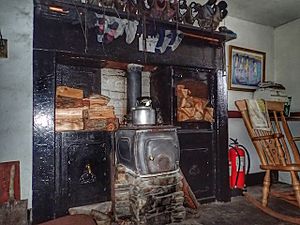Skiddaw facts for kids
Quick facts for kids Skiddaw |
|
|---|---|

Skiddaw from Ashness, Derwentwater
|
|
| Highest point | |
| Elevation | 931 m (3,054 ft) |
| Prominence | 709 m (2,326 ft) |
| Listing | Marilyn, Hewitt, Wainwright, Nuttall |
| Geography | |
| Parent range | Lake District, Northern Fells |
| OS grid | NY260290 |
| Topo map | OS Landrangers 89, 90, Explorer OL4 |
Skiddaw is a famous mountain in the beautiful Lake District National Park in England. Standing at 931 meters (3,054 feet) tall, it is the sixth-highest mountain in England. You can find it just north of the town of Keswick in Cumbria. Skiddaw is so big that it really stands out in the landscape of the northern Lake District.
Many people enjoy climbing Skiddaw because it's one of the easier tall mountains in the Lake District to hike. There's a clear path from a car park near Keswick, making it a great choice for people who don't hike often but want to experience climbing a big mountain. Skiddaw is also the first peak in a famous long-distance running challenge called the Bob Graham Round.
The mountain gives its name to the areas around it, like 'Skiddaw Forest' and 'Back o' Skidda. It also names a special building called Skiddaw House. This building, located to the east, used to be a place for hunting and later became a youth hostel. The rocks from this area are known as Skiddaw slate. People have even made musical instruments, called lithophones, from this slate. You can see some of these "Musical Stones of Skiddaw" at the Keswick Museum and Art Gallery.
Contents
Exploring Skiddaw's Landscape
The Northern Fells are a group of mountains that form a rough circle, about 10 miles (16 km) wide. In the middle of this area is a flat, marshy space called Skiddaw Forest. This treeless plateau is about 400 meters (1,300 feet) high. Rivers flow out from here, dividing the area into three main parts. Skiddaw and its smaller peaks are in the south-western part, between the Glenderaterra Beck and Dash Beck rivers.
Skiddaw itself looks like a long ridge running north to south, about half a mile (0.8 km) long. It has steep sides to the east and west. This ridge continues north to another peak called Bakestall. Other ridges spread out from the southern end of Skiddaw. To the south-east, you'll find Skiddaw Little Man, Lonscale Fell, and Latrigg. Latrigg is a popular spot because it offers easy views of Keswick and Derwentwater.
To the south-west, a ridge curves around to run north, overlooking Bassenthwaite Lake. This forms an "outer wall" for Skiddaw, made up of Carl Side, Long Side, and Ullock Pike. Together, these are known as Longside Edge. Another peak in the Skiddaw group is Dodd, which is a smaller peak connected to Carl Side.
Between Skiddaw and Longside Edge are two quiet valleys, Southerndale and Barkbethdale. These valleys drain the western slopes of Skiddaw into Bassenthwaite Lake. The eastern side of Skiddaw drains into Skiddaw Forest. Much of this water goes into Candleseaves Bog, a marsh. This marsh is where both the Dash Beck (flowing north-west to Bassenthwaite) and the River Caldew (flowing north-east to the Solway Firth near Carlisle) begin. Two smooth bumps on Skiddaw's eastern side, Sale How and Hare Crag, are sometimes listed as separate peaks in guidebooks. Sale How is also a Nuttall peak.
Skiddaw's slopes are generally smooth and rounded. From a distance, it looks like a soft, thick blanket has been draped over a frame. On the ridges, you'll find loose stones, but most of the mountain is covered in grass and heather. The famous fell walker Alfred Wainwright described Skiddaw as having "smooth lines" and "graceful curves," noting its impressive strength and beauty.
Reaching Skiddaw's Summit
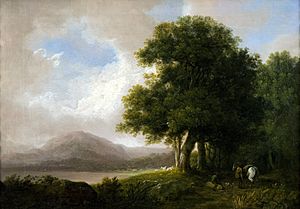
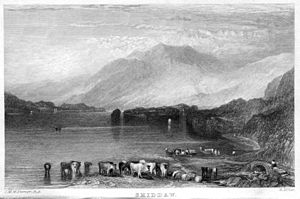
The top ridge of Skiddaw has several high points. From north to south, these are North Top, High Man (which is the very top), Middle Top, and South Top. All of these points now have cairns (piles of stones) and stone shelters to protect hikers from the wind.
Skiddaw also has a smaller peak nearby called Little Man. It's about 1.5 kilometers (1 mile) south-south-east of the main summit. Even though it's not completely separate, Alfred Wainwright listed it as its own fell in his popular guidebooks, and many people still follow this idea. Skiddaw Little Man even has its own smaller peak, called Lesser Man.
From the top of Skiddaw, you can see amazing views in every direction. To the north-east, you'll see the quiet fells of Back o'Skiddaw, with the Border hills, the Cheviots, and the North Pennines beyond them. To the south-east, you can spot Blencathra, the Far Eastern Fells, and the Helvellyn range. On clear days, you might even see parts of the Yorkshire Dales and Forest of Bowland.
The Coniston Fells are visible directly to the south. Looking past South Top, you get a great view of the Scafells, Western, and North Western Fells. On very clear days, you might even see a bit of Snowdonia in Wales, the Isle of Man (about 60 miles or 97 km away), and even the Mourne Mountains in Northern Ireland (about 120 miles or 193 km away)! To the north-west, you'll see the coastal plain and the distant Solway Firth, with hills in Galloway, Scotland, like Merrick, Criffel, and Broad Law. You can even see Goat Fell on the Isle of Arran in Scotland, about 105 miles (169 km) away.
The farthest point you can see from Skiddaw is Slieve Meelmore in the Mourne Mountains in County Down, Northern Ireland, which is about 120 miles (193 km) away. If you move to South Top, you get a fantastic view of Borrowdale.
Popular Ways to Climb Skiddaw
There are many different ways to climb Skiddaw, and most of them are not too difficult in good weather. The most popular route for visitors starts from Keswick. It first goes up behind Latrigg, then continues climbing over the slopes of Little Man to the main summit. You can save about 200 meters (650 feet) of climbing by driving to the top of Gale Road and starting from the public car park near Latrigg's summit.
Another popular way to climb (and the one recommended by Wainwright) is to follow Longside Edge. This route first goes up Ullock Pike, Longside, and Carl Side, before a steep climb from Carlside Col to the top. From the north, a slightly harder option is to walk up Buzzard Knott, then cross to the southern edge above Randel Crag and climb east to the summit. An easier option is to walk south from Cock Up (505m); reversing this route is a safe way to descend, especially in bad weather.
From the south-west, starting at Millbeck, you can reach Carlside Col directly. You can also start from nearby Applethwaite for a different version of the main tourist route. From the north-west, a tough but scenic climb can be made to the northern end of Longside Edge, then you follow the ridge to the summit. Finally, you can climb from the east by first heading to Skiddaw House, which is quite a distance from Keswick, Threlkeld, or Peter House. Once you reach Skiddaw House, you can take a fairly direct path, climbing over either Sale How or Hare Crag.
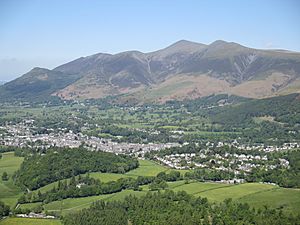
From the north-east, there's an unmarked but fairly easy and well-used path that starts at Whitewater Dash waterfall (on the Cumbrian Way). You can follow the fence along Birkett Edge, just south of Dead Crags, past the Bakestall outcrop. Continue following the fence until just before the unnamed peak at 831 meters (2,726 feet). From this 831m peak, a path leads directly to Skiddaw Man (the summit).
People have likely been climbing Skiddaw for thousands of years, long before written history. However, the first time the climb was recorded on film or video was in 1995 by a local Cumbrian photographer and filmmaker named Michael Lakey.
What's in a Name?
Early names for Skiddaw, from around the 1200s, include Skythou and Skydehow. Experts believe Skiddaw's name comes from the Old Norse words skyti or skut + haugr. This could mean "archer's hill" or "jutting crag hill."
Skiddaw House: A Mountain Home
Below Sale How, you'll find Skiddaw House. This stone building has had many uses over the years. It has been a shooting lodge (a base for hunting), a shepherd's bothy (a simple shelter for shepherds), and a Youth Hostel. The only trees in Skiddaw Forest are those that act as a windbreak for the house. You can reach it by a long track that goes up the Dash Valley.
The house was built around 1829 by the Earl of Egremont. It was originally a lodge for gamekeepers, used as a base for grouse hunting and for managing the Earl's large land in Skiddaw Forest.
Not much is known about the house in the 1800s. However, it was used by both gamekeepers and shepherds after 1860, and it had rooms for the Earl and his hunting parties. Canon Rawnsley, one of the people who helped start the National Trust, visited around 1900. He wrote about how welcoming the shepherd's family was at that time. Sir Hugh Walpole, who wrote a Lake District novel called Rogue Herries, visited in the 1920s and 30s. He even used the house as the setting for a murder scene in his book, set in 1854.
People continued to live in the house until the early 1950s. Several families raised their children there until they were old enough to go to school. The longest resident was probably Pearson Dalton, a shepherd who lived there alone for five days a week from 1952 to 1969. By then, farming methods had changed, and the house was no longer needed for its original purpose. It fell into disrepair, although various schools and outdoor groups used it sometimes.
In 1986, a man named John Bothamley leased the house. He had already created the YHA Carrock Fell Hostel nearby. Eventually, the building was given to the YHA. It closed in 2002 because of a disagreement about the lease. In 2007, it reopened as an independent hostel, run by the Skiddaw House Foundation, as part of the YHA's franchising program.
Skiddaw in Literature
Skiddaw is mentioned in the fourth book of John Keats's famous poem Endymion: "…with all the stress / Of vision search'd for him, as one would look […] from old Skiddaw's top, when fog conceals / His rugged forehead in a mantle pale, / With an eye-guess towards some pleasant vale / Descry a favourite hamlet faint and far."
Skiddaw is also mentioned in the final lines of the poem The Armada by Thomas Babington Macaulay, Lord Macaulay:
- "Till Skiddaw saw the fire that burned on Gaunt's embattled pile,
- And the red glare on Skiddaw roused the burghers of Carlisle."



